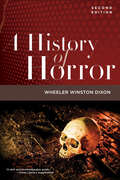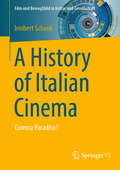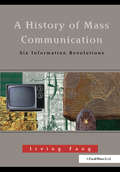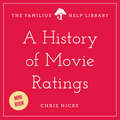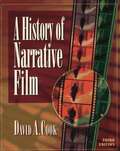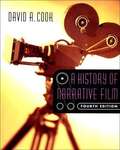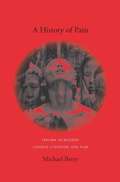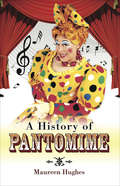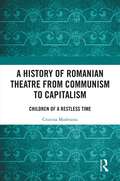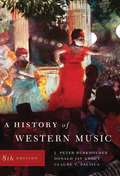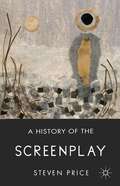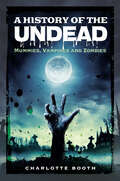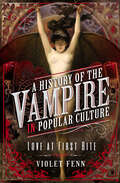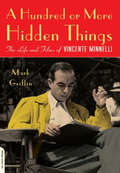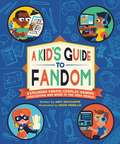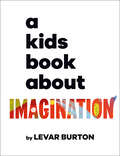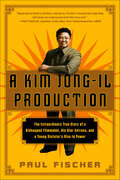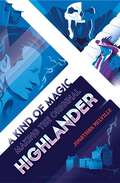- Table View
- List View
A History of Heavy Metal: 'Absolutely hilarious' – Neil Gaiman
by Andrew O'Neill'Absolutely hilarious' - Neil Gaiman'One of the funniest musical commentators that you will ever read . . . loud and thoroughly engrossing' - Alan Moore'A man on a righteous mission to persuade people to "lay down your souls to the gods rock and roll".' - The Sunday Times'As funny and preposterous as this mighty music deserve' - John HiggsThe history of heavy metal brings brings us extraordinary stories of larger-than-life characters living to excess, from the household names of Ozzy Osbourne, Lemmy, Bruce Dickinson and Metallica (SIT DOWN, LARS!), to the brutal notoriety of the underground Norwegian black metal scene and the New Wave Of British Heavy Metal. It is the story of a worldwide network of rabid fans escaping everyday mundanity through music, of cut-throat corporate arseholes ripping off those fans and the bands they worship to line their pockets. The expansive pantheon of heavy metal musicians includes junkies, Satanists and murderers, born-again Christians and teetotallers, stadium-touring billionaires and toilet-circuit journeymen. Award-winning comedian and life-long heavy metal obsessive Andrew O'Neill has performed his History of Heavy Metal comedy show to a huge range of audiences, from the teenage metalheads of Download festival to the broadsheet-reading theatre-goers of the Edinburgh Fringe. Now, in his first book, he takes us on his own very personal and hilarious journey through the history of the music, the subculture, and the characters who shaped this most misunderstood genre of music.
A History of Heavy Metal: 'Absolutely hilarious' – Neil Gaiman
by Andrew O'Neill'Absolutely hilarious' - Neil Gaiman'One of the funniest musical commentators that you will ever read . . . loud and thoroughly engrossing' - Alan Moore'Relentlessly energetic and frequently hilarious' - The Herald'A man on a righteous mission to persuade people to "lay down your souls to the gods rock and roll"' - The Sunday Times'A love letter to Heavy Metal' - BBC RADIO 4 'As funny and preposterous as this mighty music deserve' - John HiggsThe history of heavy metal brings brings us extraordinary stories of larger-than-life characters living to excess, from the household names of Ozzy Osbourne, Lemmy, Bruce Dickinson and Metallica (SIT DOWN, LARS!), to the brutal notoriety of the underground Norwegian black metal scene and the New Wave Of British Heavy Metal. It is the story of a worldwide network of rabid fans escaping everyday mundanity through music, of cut-throat corporate arseholes ripping off those fans and the bands they worship to line their pockets. The expansive pantheon of heavy metal musicians includes junkies, Satanists and murderers, born-again Christians and teetotallers, stadium-touring billionaires and toilet-circuit journeymen. Award-winning comedian and life-long heavy metal obsessive Andrew O'Neill has performed his History of Heavy Metal comedy show to a huge range of audiences, from the teenage metalheads of Download festival to the broadsheet-reading theatre-goers of the Edinburgh Fringe. Now, in his first book, he takes us on his own very personal and hilarious journey through the history of the music, the subculture, and the characters who shaped this most misunderstood genre of music.
A History of Horror, 2nd Edition
by Wheeler Winston DixonEver since horror leapt from popular fiction to the silver screen in the late 1890s, viewers have experienced fear and pleasure in exquisite combination. Wheeler Winston Dixon's fully revised and updated A History of Horror is still the only book to offer a comprehensive survey of this ever-popular film genre. Arranged by decades, with outliers and franchise films overlapping some years, this one-stop sourcebook unearths the historical origins of characters such as Dracula, Frankenstein, and the Wolfman and their various incarnations in film from the silent era to comedic sequels. In covering the last decade, this new edition includes coverage of the resurgence of the genre, covering the swath of new groundbreaking horror films directed by women, Black and queer horror films, and a new international wave in body horror films. A History of Horror explores how the horror film fits into the Hollywood studio system, how the distribution and exhibition of horror films have changed in a post-COVID world, and how its enormous success in American and European culture expanded globally over time. Dixon examines key periods in the horror film-in which the basic precepts of the genre were established, then banished into conveniently reliable and malleable forms, and then, after collapsing into parody, rose again and again to create new levels of intensity and menace. A History of Horror, supported by rare stills from classic films, brings over sixty timeless horror films into frightfully clear focus, zooms in on today's top horror Web sites, and champions the stars, directors, and subgenres that make the horror film so exciting and popular with contemporary audiences.
A History of Italian Cinema: Cinema Paradiso? (Film und Bewegtbild in Kultur und Gesellschaft)
by Irmbert SchenkThis book provides a complete description of the development of Italian film and cinema from its beginnings in 1895 until today. Special emphasis is placed on those periods in which Italian film history became aesthetically decisive for world cinematography: silent film of the 1910s, neorealism after World War II, and auteur and genre cinema around 1960. And then on the multifaceted development up to the present day, which still guarantees films from Italy a significant place in international cinema. The chapters are introduced with compact descriptions of Italy's political and social history and the institutional formation of film and cinema. This is the basis for the extensive examination of genres and films. The film analyses also include a look at the reception by the audiences.
A History of Mass Communication: Six Information Revolutions
by Irving FangThis exciting new text traces the common themes in the long and complex history of mass communication. It shows how the means of communicating grew out of their eras, how they developed, how they influenced the societies of those eras, and how they have continued to exert their influence upon subsequent generations. The book is divided into six periods which are identified as 'Information Revolutions' writing, printing, mass media, entertainment, the 'toolshed' (which we call 'home' now), and the Information Highway. In looking at the ways in which the tools of communication have influenced and been influenced by social change, A History of Mass Communication provides students of media and journalism with a strong sense of the way their chosen field affects how society functions. Providing a broad-based approach to media history, Dr. Fang encourages the reader to take a careful look at where our culture is headed through the tools we use to communicate with one another.A History of Mass Communication is not only the most current text on communication history, but also an invaluable resource for anyone interested in how methods of communication affect society.
A History of Movie Ratings
by Chris HicksThe wire-thin line that separates movies rated PG and R has been crossed over so many times in both directions that industry observers are questioning whether the rating system carries any validity at all. Just where did this system come from? And who's been trusted with dishing out the ratings anyway? As a movie reviewer for more than thirty years, author Chris Hicks knows a thing or two about Hollywood. His masterful synopsis of CARA, the MPAA, and the mess we're in today will make you think twice before you take a film rating at face value.
A History of Narrative Film (3rd ed.)
by David A. CookThe most comprehensive and complete history of international cinema in print.
A History of Narrative Film (4th edition)
by David A. CookSuitable as both a reference and a teaching text, this volume integrates film history and aesthetics with an analysis of the technological, social, and economic contexts of world cinema. It concentrates on narrative film, excluding documentary cinema, animated cinema, and the experimental avant-garde. The fourth edition features a new chapter on computer generated imaging as well as a new section of plates illustrating the development of color film technologies. Annotation ©2004 Book News, Inc., Portland, OR (booknews.com)
A History of Pain
by Michael BerryThe portrayal of historical atrocity in fiction, film, and popular culture can reveal much about the function of individual memory and the shifting status of national identity. In the context of Chinese culture, films such as Hou Hsiao-hsien's City of Sadness and Lou Ye's Summer Palace and novels such as Ye Zhaoyan's Nanjing 1937: A Love Story and Wang Xiaobo's The Golden Age collectively reimagine past horrors and give rise to new historical narratives.Michael Berry takes an innovative look at the representation of six specific historical traumas in modern Chinese history: the Musha Incident (1930); the Rape of Nanjing (1937-38); the February 28 Incident (1947); the Cultural Revolution (1966-76); Tiananmen Square (1989); and the Handover of Hong Kong (1997). He identifies two primary modes of restaging historical violence: centripetal trauma, or violence inflicted from the outside that inspires a reexamination of the Chinese nation, and centrifugal trauma, which, originating from within, inspires traumatic narratives that are projected out onto a transnational vision of global dreams and, sometimes, nightmares.These modes allow Berry to connect portrayals of mass violence to ideas of modernity and the nation. He also illuminates the relationship between historical atrocity on a national scale and the pain experienced by the individual; the function of film and literature as historical testimony; the intersection between politics and art, history and memory; and the particular advantages of modern media, which have found new means of narrating the burden of historical violence.As Chinese artists began to probe previously taboo aspects of their nation's history in the final decades of the twentieth century, they created texts that prefigured, echoed, or subverted social, political, and cultural trends. A History of Pain acknowledges the far-reaching influence of this art and addresses its profound role in shaping the public imagination and conception-as well as misconception-of modern Chinese history.
A History of Pain: Trauma in Modern Chinese Literature and Film (Global Chinese Culture)
by Michael BerryThe portrayal of historical atrocity in fiction, film, and popular culture can reveal much about the function of individual memory and the shifting status of national identity. In the context of Chinese culture, films such as Hou Hsiao-hsien's City of Sadness and Lou Ye's Summer Palace and novels such as Ye Zhaoyan's Nanjing 1937: A Love Story and Wang Xiaobo's The Golden Age collectively reimagine past horrors and give rise to new historical narratives.Michael Berry takes an innovative look at the representation of six specific historical traumas in modern Chinese history: the Musha Incident (1930); the Rape of Nanjing (1937-38); the February 28 Incident (1947); the Cultural Revolution (1966-76); Tiananmen Square (1989); and the Handover of Hong Kong (1997). He identifies two primary modes of restaging historical violence: centripetal trauma, or violence inflicted from the outside that inspires a reexamination of the Chinese nation, and centrifugal trauma, which, originating from within, inspires traumatic narratives that are projected out onto a transnational vision of global dreams and, sometimes, nightmares. These modes allow Berry to connect portrayals of mass violence to ideas of modernity and the nation. He also illuminates the relationship between historical atrocity on a national scale and the pain experienced by the individual; the function of film and literature as historical testimony; the intersection between politics and art, history and memory; and the particular advantages of modern media, which have found new means of narrating the burden of historical violence. As Chinese artists began to probe previously taboo aspects of their nation's history in the final decades of the twentieth century, they created texts that prefigured, echoed, or subverted social, political, and cultural trends. A History of Pain acknowledges the far-reaching influence of this art and addresses its profound role in shaping the public imagination and conception-as well as misconception-of modern Chinese history.
A History of Pantomime
by Maureen HughesEach Christmas entire families in the UK troop off to see, what one could almost say is 'the obligatory'. annual entertainment, known as Pantomime. It is a traditional, seasonal way of life for the British envied the world over, and one which only the British seem to understand! Pantomime serves both to entertain and to introduce each new generation to the joys of theatre in the most unique of ways, for this is not a type of theatre one merely watches, but one in which the audience participate often in the most seemingly boisterous and bizarre of ways. The whole experience is steeped in tradition, traditions which only the British seem to understand, which is probably why we are proud to call it a 'British Experience.'In A History of Pantomime Maureen Hughes takes a brief look at the history of Pantomime as well as taking a humorous look at some of the above mentioned traditions; she also gives a synopsis of each of the well-known Pantomimes whilst exploring the eccentric world of the characters who appear in them. There is also a short piece on just some of the most well-known and loved of the actors who each Christmas take on the part of Pantomime Dames across the UK, as well as a look at others who have contributed to this magical world of fun and eccentricity. It is thought by some to be frivolous and pointless piece of theatre, but a browse through this informative book and you will soon find that Pantomime is an art form all of its own, requiring the most dedicated and talented of actors/actresses who are prepared to honour and perpetuate this wonderful tradition as it is passed down from one generation to the next.As seen in The Telegraph and the Sunday Post (Glasgow).
A History of Regional Commercial Television in Australia
by Michael ThurlowThis book is the first history of commercial television in regional Australia, where diverse communities are spread across vast distances and multiple time zones. The first station, GLV Latrobe Valley, began broadcasting in December 1961. By the late 1970s, there were 35 independent commercial stations throughout regional Australia, from Cairns in the far north-east to Bunbury in the far south-west. Based on fine-grained archival research and extensive interviews, the book examines the key political, regulatory, economic, technological, industrial, and social developments which have shaped the industry over the past 60 years. Regional television is often dismissed as a mere extension of – or footnote to – the development of Australia’s three metropolitan commercial television networks. Michael Thurlow’s study reveals an industry which, at its peak, was at the economic and social heart of regional communities, employing thousands of people and providing vital programming for viewers in provincial cities and small towns across Australia.
A History of Romanian Theatre from Communism to Capitalism: Children of a Restless Time
by Cristina ModreanuA History of Romanian Theatre from Communism to Capitalism analyses the last three decades of Romanian theatre and connects it to the international stage. Cristina Modreanu questions the relationship between artists and power, both before 1989, behind the Iron Curtain, and in the current global political context, with nationalism manifesting itself in Eastern Europe, as seen in the critical work of Romanian theatre makers. This study covers the complex cases of theatre makers such as Lucian Pintilie, Liviu Ciulei and Andrei Șerban, who built their international careers in exile, and the most innovative Romanian artists of today, such as Silviu Purcărete, Mihai Măniuţiu, Gianina Cărbunariu, Radu Afrim, and Bogdan Georgescu, who reached the status of transglobal artists. Filling a considerable gap in Romanian theatre discourse, this book will be of a great interest to students and scholars of contemporary theatre and history.
A History of Western Music (8th edition)
by J. Peter Burkholder Donald Jay Grout Claude V. PaliscaThe Eighth Edition of A History of Western Music is a vivid, accessible, and richly contextual view of music in Western culture.
A History of the Screenplay
by Steven PriceThe screenplay is currently the focus of extensive critical re-evaluation, however, as yet there has been no comprehensive study of its historical development. International in scope and placing emphasis on the development and variety of screenplay texts themselves, this book will be an important and innovative addition to the current literature.
A History of the Undead: Mummies, Vampires and Zombies
by Charlotte BoothA history of Western culture’s fascination with undead creatures in film and television.Are you a fan of the undead? Watch lots of mummy, zombie and vampire movies and TV shows? Have you ever wondered if they could be “real?”This book, A History of the Undead, unravels the truth behind these popular reanimated corpses.Starting with the common representations in Western media through the decades, we go back in time to find the origins of the myths. Using a combination of folklore, religion and archaeological studies we find out the reality behind the walking dead. You may be surprised at what you find . . .
A History of the Undead: Mummies, Vampires and Zombies
by Charlotte BoothA history of Western culture’s fascination with undead creatures in film and television.Are you a fan of the undead? Watch lots of mummy, zombie and vampire movies and TV shows? Have you ever wondered if they could be “real?”This book, A History of the Undead, unravels the truth behind these popular reanimated corpses.Starting with the common representations in Western media through the decades, we go back in time to find the origins of the myths. Using a combination of folklore, religion and archaeological studies we find out the reality behind the walking dead. You may be surprised at what you find . . .
A History of the Vampire in Popular Culture: Love at First Bite
by Violet FennAn exploration of the continuing appeal of vampires in cultural and social history. Our enduring love of vampires—the bad boys (and girls) of paranormal fantasy—has persisted for centuries. Despite being bloodthirsty, heartless killers, vampire stories commonly carry erotic overtones that are missing from other paranormal or horror stories. Even when monstrous teeth are sinking into pale, helpless throats—especially then—vampires are sexy. But why? In A History Of The Vampire In Popular Culture, author Violet Fenn takes the reader through the history of vampires in &“fact&” and fiction, their origins in mythology and literature, and their enduring appeal on TV and film. We&’ll delve into the sexuality--and sexism--of vampire lore, as well as how modern audiences still hunger for a pair of sharp fangs in the middle of the night.
A Horrible Experience of Unbearable Length: More Movies That Suck
by Roger EbertMore of the Pulitzer Prize–winning film critic’s most scathing reviews.A Horrible Experience of Unbearable Length collects more than 200 of his reviews from 2006 to 2012 in which he gave movies two stars or fewer. Known for his fair-minded and well-written film reviews, Roger is at his razor-sharp humorous best when skewering bad movies. Consider this opener for the one-star Your Highness:“Your Highness is a juvenile excrescence that feels like the work of 11-year-old boys in love with dungeons, dragons, warrior women, pot, boobs, and four-letter words. That this is the work of David Gordon Green beggars the imagination. One of its heroes wears the penis of a minotaur on a string around his neck. I hate it when that happens.”And finally, the inspiration for the title of this book, the one-star Transformers: Revenge of the Fallen:“Transformers: Revenge of the Fallen is a horrible experience of unbearable length, briefly punctuated by three or four amusing moments. One of these involves a doglike robot humping the leg of the heroine. If you want to save yourself the ticket price, go into the kitchen, cue up a male choir singing the music of hell, and get a kid to start banging pots and pans together. Then close your eyes and use your imagination.”Roger Ebert’s I Hated, Hated, Hated This Movie and Your Movie Sucks, which gathered some of his most scathing reviews, were bestsellers. This collection continues the tradition, reviewing not only movies that were at the bottom of the barrel, but also movies that he found underneath the barrel. Movie buffs and humor lovers alike will relish this treasury of movies so bad that you may just want to see them for a good laugh!
A Horrible Experience of Unbearable Length: More Movies That Suck
by Roger EbertMore of the Pulitzer Prize–winning film critic’s most scathing reviews.A Horrible Experience of Unbearable Length collects more than 200 of his reviews from 2006 to 2012 in which he gave movies two stars or fewer. Known for his fair-minded and well-written film reviews, Roger is at his razor-sharp humorous best when skewering bad movies. Consider this opener for the one-star Your Highness:“Your Highness is a juvenile excrescence that feels like the work of 11-year-old boys in love with dungeons, dragons, warrior women, pot, boobs, and four-letter words. That this is the work of David Gordon Green beggars the imagination. One of its heroes wears the penis of a minotaur on a string around his neck. I hate it when that happens.”And finally, the inspiration for the title of this book, the one-star Transformers: Revenge of the Fallen:“Transformers: Revenge of the Fallen is a horrible experience of unbearable length, briefly punctuated by three or four amusing moments. One of these involves a doglike robot humping the leg of the heroine. If you want to save yourself the ticket price, go into the kitchen, cue up a male choir singing the music of hell, and get a kid to start banging pots and pans together. Then close your eyes and use your imagination.”Roger Ebert’s I Hated, Hated, Hated This Movie and Your Movie Sucks, which gathered some of his most scathing reviews, were bestsellers. This collection continues the tradition, reviewing not only movies that were at the bottom of the barrel, but also movies that he found underneath the barrel. Movie buffs and humor lovers alike will relish this treasury of movies so bad that you may just want to see them for a good laugh!
A Hundred or More Hidden Things: The Life and Films of Vincente Minnelli
by Mark GriffinIn this biography, Griffin, a writer and reviewer, traces the life and films of filmmaker Vincente Minelli (1903-1986), director of Meet Me in St. Louis, An American in Paris, and Gigi. Drawing from interviews with actors, colleagues, and friends (but neither of his daughters), Griffin recounts his childhood, unconventional upbringing, ambiguous sexuality, the autobiographical nature of his work, his work with famous actors, his many films, his family secrets, his marriages, including to Judy Garland, and his relationship with daughter Liza Minelli. Annotation ©2010 Book News, Inc. , Portland, OR (booknews. com)
A Kid's Guide to Fandom: Exploring Fan-Fic, Cosplay, Gaming, Podcasting, and More in the Geek World!
by Amy RatcliffeHelp young fans get in touch with their inner geeks with the ultimate guidebook for creating, sharing, and enjoying the world of fandom.Being a fan is a big deal. Whether it's comics, video games, podcasts, cosplay, books, films, or something else, there are so many ways to share and celebrate with the things that you love. So, it's high time for a guide to help young fans navigate the world of fandom and its many flourishing communities—from fan works to cosplay, gaming, podcasting, and more!Filled with history, trivia, tips and advice to getting started, and insight from creators and artists from across pop culture and specializing in a wide variety of mediums, A Kid's Guide to Fandom is the perfect geeky primer for young fans. Organized by type of fandom medium, each chapter offers a brief introduction, facts, history sidebars, and easy to digest information on how to:Create Fan Fic or Fan ArtDesign and Create a CosplayStart a PodcastDesign and Create Games (video games, tabletop, and other role playing games)Find and Create Supportive CommunitiesFind and Attend Conventions Plus, interviews with popular creatives like Alan Gratz, Erin Lefler, Jen Bartel, Daniel José Older, Rose Eveleth, Kat Kruger, Jordan Dené Ellis, Liz Crowder, and more.
A Kids Book About Imagination: Kids Are Ready (A Kids Book)
by LeVar BurtonA clear explanation of what the imagination is and the opportunities that come from the use of it. What is imagination? Most of us think of it as playing pretend or what happens when we&’re dreaming, but imagination takes us to worlds and galaxies beyond that. Imagination helps us travel between time, space, and reality. It gives us the power to dream up the world in our own vision and encourages us to think of not just what is, but what could be.Imagination is a superpower that unlocks endless possibilities, and all by asking one simple question: what if? This is one conversation that&’s never too early to start, and this book was written to be an introduction on the topic for kids.A Kids Book About Imagination features: - A large and bold, yet minimalist font design that allows kids freedom to imagine themselves in the words on the pages.- A friendly, approachable, yet empowering, kid-appropriate tone throughout.- An incredible and diverse group of authors in the series who are experts or have first-hand experience of the topic.Tackling important discourse together! The A Kids Book About series are best used when read together. Helping to kickstart challenging, empowering, and important conversations for kids and their grownups through beautiful and thought-provoking pages. The series supports an incredible and diverse group of authors, who are either experts in their field, or have first-hand experience on the topic. A Kids Co. is a new kind of media company enabling kids to explore big topics in a new and engaging way. With a growing series of books, podcasts and blogs, made to empower. Learn more about us online by searching for A Kids Co.
A Kim Jong-Il Production: The Extraordinary True Story of a Kidnapped Filmmaker, His Star Actress, and a Young Dictator's Rise to Power
by Paul FischerBefore becoming the world's most notorious dictator, Kim Jong-Il ran North Korea's Ministry for Propaganda and its film studios. Conceiving every movie made, he acted as producer and screenwriter. Despite this control, he was underwhelmed by the available talent and took drastic steps, ordering the kidnapping of Choi Eun-Hee (Madam Choi)—South Korea's most famous actress—and her ex-husband Shin Sang-Ok, the country's most famous filmmaker.Madam Choi vanished first. When Shin went to Hong Kong to investigate, he was attacked and woke up wrapped in plastic sheeting aboard a ship bound for North Korea. Madam Choi lived in isolated luxury, allowed only to attend the Dear Leader's dinner parties. Shin, meanwhile, tried to escape, was sent to prison camp, and "re-educated." After four years he cracked, pledging loyalty. Reunited with Choi at the first party he attends, it is announced that the couple will remarry and act as the Dear Leader's film advisors. Together they made seven films, in the process gaining Kim Jong-Il's trust. While pretending to research a film in Vienna, they flee to the U.S. embassy and are swept to safety.A nonfiction thriller packed with tension, passion, and politics, author Paul Fischer's A Kim Jong-Il Production offers a rare glimpse into a secretive world, illuminating a fascinating chapter of North Korea's history that helps explain how it became the hermetically sealed, intensely stage-managed country it remains today.
A Kind of Magic: Making the Original Highlander
by Jonathan MelvilleA behind-the-scenes look at the making of the classic 1986 fantasy action-adventure film, featuring insights from the cast and crew.The story of an immortal Scottish warrior battling evil down through the centuries, Highlander fused a high-concept idea with the kinetic energy of a pop promo pioneer and Queen’s explosive soundtrack to become a cult classic.When two American producers took a chance on a college student’s script, they set in motion a chain of events involving an imploding British film studio, an experimental music video director still finding his filmmaking feet, a former James Bond with a spiralling salary, and the unexpected arrival of low-budget production company, Cannon Films.Author Jonathan Melville looks back at the creation of Highlander with the help of more than 60 cast and crew, including stars Christopher Lambert and Clancy Brown, as they talk candidly about the gruelling shoot that took them from the back alleys of London, to the far reaches of the Scottish Highlands, and onto the mean streets of 1980s New York City.With insights from Queen’s Brian May and Roger Taylor on the film’s iconic music, exclusive screenwriter commentary on unmade scripts, never-before-seen photos from private collections, and a glimpse into the promotional campaign that never was, if there can be only one book on Highlander then this is it!“A Kind of Magic: Making the Original Highlander tracks down an astonishing number of the film's cast and crew to give an unparalleled account of its creation . . . if you’re one of the film’s many fans this is the perfect companion.” —The Courier, Book of the Week, 9/10As well as being the story of the Highlander film itself, it’s a fascinating look at the film-making process . . . Jonathan Melville’s A Kind of Magic: Making the Original Highlander is an absolute joy to read and an absolutely essential purchase for any Highlander fan.” —We Are Cult

